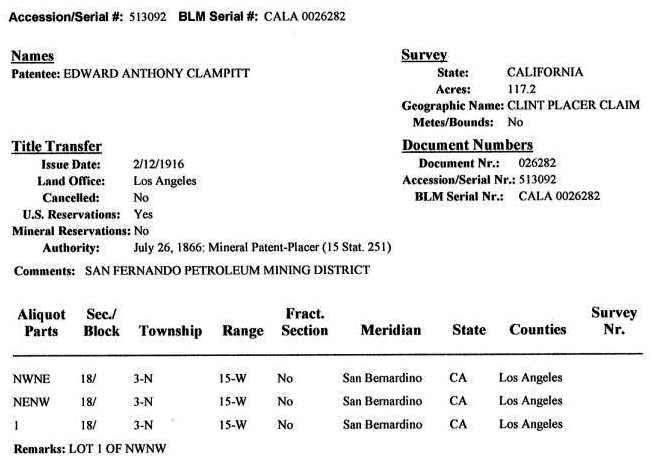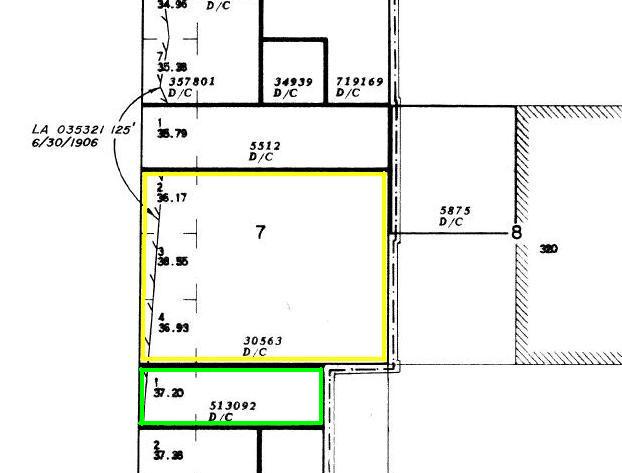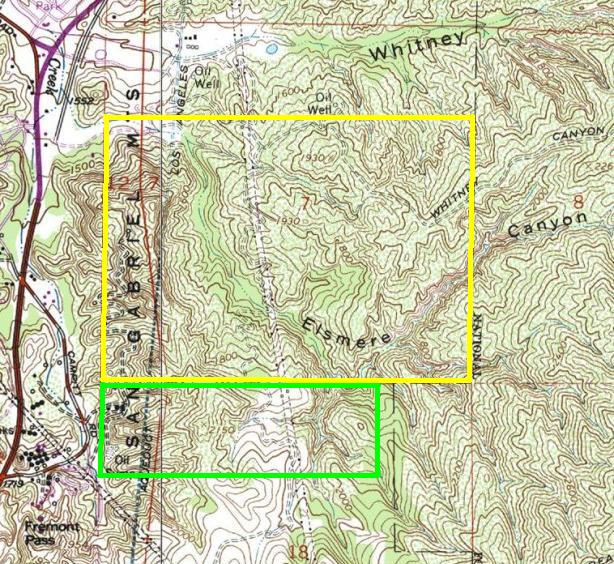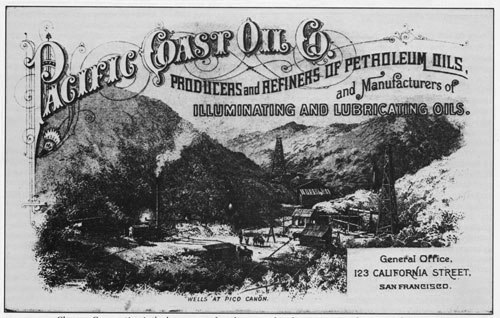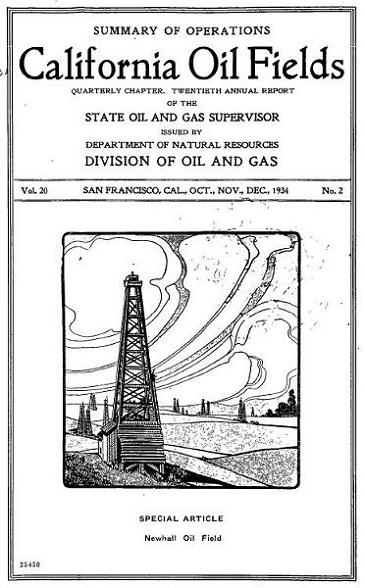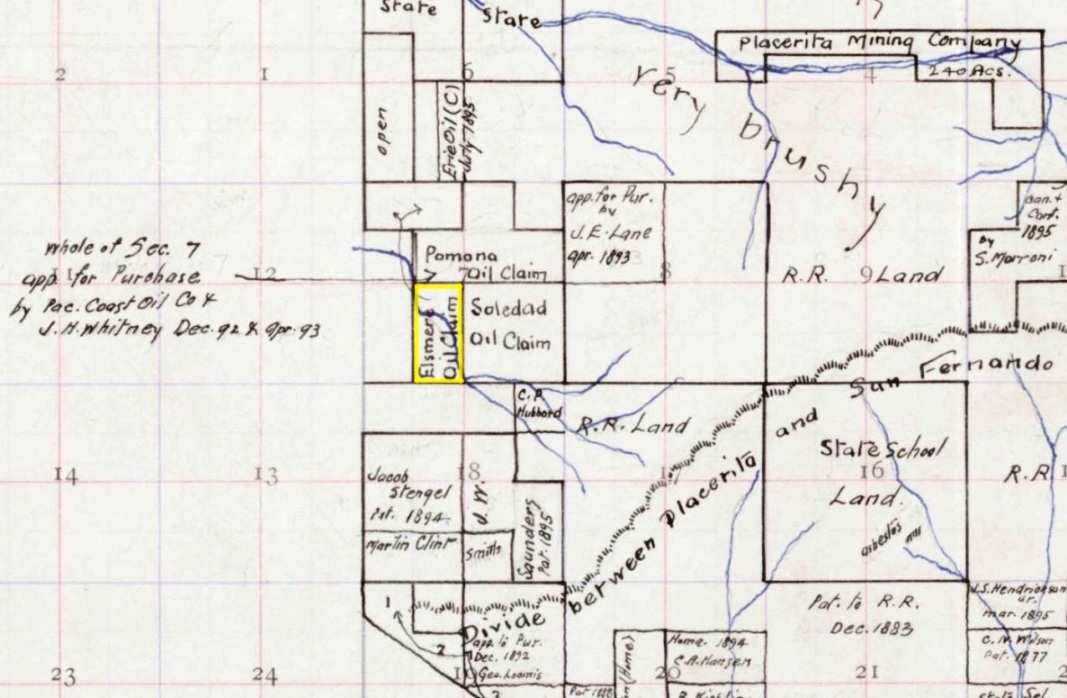
"A few days ago Mr. M. Kraszynski, who lives near Lyons Station, while passing up an arroyo in that locality, discovered thirty-two flowing oil springs within a short distance of each other."Los Angeles Herald, August 22, 1874:
"In company with Captain Kraszynski of Lyon Station, I yesterday went to see the oil deposits in this vicinity, and was greatly astonished at the splendid show of oil that we saw. The first claims we went to see were the Clara and Danbury, which are located about one mile from Lyon Station, and are undoubtedly the best claims in the district. Riding up a canyon [Elsmere] completely shut in from the outside world by high cliffs, and along a creek covered on either side by dense groves of willows, we soon come to a group of oil springs seven or eight in number all situated within a short distance of each other. We examined them closely; the oil appeared to come from little crevices in the rocks, and flowed a small stream of oil continuously. Continuing our way up the canyon we came to numerous springs, and they kept increasing until the ground was literally covered with oil.Ventura Signal, September 19, 1874:
Far up the sides of the mountain and in the gulches, springs of oil were bursting out and it seemed to be everywhere. It was a grand sight amid the wild mountains, to see this immense wealth scattered over the face of the whole mountain and canyon, and forming a chain of springs that extend for many miles through the country. Entering a dense grove of willows, we came to a spring that boiled up a fine stream of oil and would be a splendid place to bore a well. We saw about one hundred and thirty springs of oil within one mile along the canyon. The ground in many places is saturated with it; dig a hole where you may, in a few hours the water will be covered with a scum of oil. The Clara and Danbury claims will yet become famous throughout the country. They are the property of Captain M. Kraszynski, the enterprising discoverer who has constructed an excellent road to the springs, and is constantly discovering new oil deposits in the mountains and canyons in the vicinity of this place. Situated as these springs are, within one mile of the oil refinery [at Lyon's Station], they are the richest and finest located in San Fernando."
"Our party consisted of four in number, under the guidance of Captain Kraszynski, who has large interests in the Clara and Danbury claims located there. A carriage drive winds along the foot of the mountains and for some distance up the canyon, where the oil springs first make their appearance. They are almost numberless, the oil spreading over the ground in all directions. This oil has been pronounced by experts to be of the finest quality. We were told the existence of these springs has been known for many years, the oil being bottled for medicinal purposes, without a suspicion of its being petroleum until quite recently. Here, under the branches of lofty trees, amid the silence and loneliness of nature, is one of the greatest resources of wealth of Southern California.Pittsburgh Daily Commercial, October 6, 1874:
After proceeding some distance up the canyon, as far as the drive would permit, we mounted on little ponies and rode up the narrow defile to the boiling springs, which presented a very interesting appearance. The basins of the springs are several feet in diameter, and in a state of violent ebullition, as diabolical in appearance as the witches' caldron in Macbeth, needing but the presence of Hecate and her wierd band to realize that horrible creation of poetic fancy.
We proceeded up this canyon for some miles, the scenery growing wilder at every turn. Vistas of light broke through the pines that crown the mountains towering above us on each side, several hundred feet. Then the springs increased at every point, the oil oozing through the crevices of the rocks on every side. The here is exceedingly bitter, and the ground fairly covered with the black tarry substance."
"We next day looked at the Great Eastern, Santa Clara, Dunkirk, and Mountain view claims, just east of the hotel. Of these the first two present the most advantages, having plenty of wood, good water and lie just off the stage road. Here are numerous springs of thick, black oil, which oozing out, has formed large beds of brea, similar to those around the Pico and Wyle Springs. No digging has been done here, and no green petroleum is seen on the surface. At several places where the oil and gas bubbles up, the oil is greenish and aniline colors are seen. Capt. M. Kraszynski and A.J. Kraszynski, who keep the hotel and are largely interested in these claims, inform me that there are over a hundred of these springs in the canyon [Elsmere]. We saw a great many but had neither time nor inclination to visit all."Los Angeles Herald, October 21, 1874:
"Just east of the hotel [Lyon's Station] is a large canyon [Elsmere], well wooded and plentifully supplied with water. The first springs of oil were discovered about half a mile from the hotel, and thence extended for a mile and a half up. Nearly a hundred and fifty have been discovered in this canyon alone. A large number of claims have been taken up here, as well as on the opposite side of the mountains."Los Angeles Herald, November 20, 1874:
"Though nine years have passed since the first discover of oil was made in California, no one knew or thought of the numerous springs of oil in the canyon [Elsmere Canyon], scarcely a quarter of a mile from the pleasant station [Lyon's Station] presided over by the Messrs. Kraszynski, who have made discoveries of numerous oil springs and have secured a number of the most desirable claims in the District."Los Angeles Herald, March 28, 1875:
"On the opposite side of the valley and about three miles East of Lyons' Station, excellent oil indication are also found. They are in a deep canyon [Elsmere] and situated similar to the others which we have mentioned. Captain Kraszynski is the original locator of these claims - eight in number - and still retains a controlling interest in them. At several places along this canyon we saw pools where the petroleum rose to the surface and flowed slowly away. On of these, high up on the mountain side, is dubbed 'The Chimney,' and shows remarkably good indications. Another, called 'The Danbury,' shows a surface of petroleum about six feet in circumference and is continually bubbling with the gas which rises through it."
| First Drilled By (Last Owner) | Well No. | Year Drilling Started | Original/max depth(ft) | Production | Remarks |
|---|---|---|---|---|---|
| Pacific Coast Oil Co (Chevron) | Elsmere 1 | 1889 | 1376 | Showings of oil & gas. No production. | Caving in and water problems. Abandoned 1890. Plugged in 1990. |
| Pacific Coast Oil Co (Chevron) | Elsmere 2 | 1890 | 600/1226 | 12 bpd Apr. 1891; 6 bpd 1894 | Still producing in 1954. Plugged in 1977. |
| Pacific Coast Oil Co (Chevron) | Elsmere 3 | 1891 | 555 | Small showing of oil with water | Abandoned-could not shut off water. Plugged in 1991. |
| Pacific Coast Oil Co (Chevron) | Elsmere 4 | 1891 | 705 | Small showing of oil and gas | Abandoned. Plugged in 1991. |
| Pacific Coast Oil Co (Chevron) | Elsmere 5 | 1898 | 555 | Init. prod. 23 bpd. Producing in 1954 | Last prod. 2 bpd oil and 3 bpd water in 1929. Plugged in 1977. |
| Pacific Coast Oil Co (Chevron) | Elsmere 6 | 1898 | 395/1020 | 40 bpd Nov. 1898. 21 bpd 1913. 1-3 bpd in 1929 | Deepened in 1913. Producing in 1954. Plugged in 1977. |
| Pacific Coast Oil Co (Chevron) | Elsmere 7 | 1898 | 435/1140 | 20 bpd in 1899. 8 bpd in 1913. 1.5 bpd in 1929. | Deepened in 1913. Producing in 1954. Plugged in 1977. |
| Pacific Coast Oil Co (Chevron) | Elsmere 8 | 1899 | 500 | Several showings oil and gas. No prod. | Abandoned - unable to shut off water. Plugged 1991. |
| Pacific Coast Oil Co (Chevron) | Elsmere 9 | 1899 | 600 | Init. prod. 23 bpd 1899. 1 bpd in 1929. | Producing in 1954. Plugged in 1977. |
| Pacific Coast Oil Co (Chevron) | Elsmere 10 | 1899 | 930/997 | No record of initial prod. 2 bpd in 1929. | Producing in 1954. Plugged in 1977. |
| Pacific Coast Oil Co (Chevron) | Elsmere 11 | 1899 | 700 | Several showings oil & gas. No prod. | Abandoned - unable to shut off water. Plugged in 1991. |
| Pacific Coast Oil Co (Chevron) | Elsmere 12 | 1900 | 1225 | Several showings oil & gas. No prod. | Abandoned - unable to shut off water. Plugged in 1991. |
| Pacific Coast Oil Co (Chevron) | Elsmere 13 | 1899 | 645/1895 | Produced. No record of initial prod. | Abandoned in 1912. Plugged in 1991. |
| Pacific Coast Oil Co (Chevron) | Elsmere 14 | 1900 | 490 | Produced very little | Abandoned 1900. Plugged in 1991. |
| Pacific Coast Oil Co (Chevron) | Elsmere 15 | 1900 | 995 | Produced. No record of initial prod. | Abandoned 1913. Plugged 1991. |
| Pacific Coast Oil Co (Chevron) | Elsmere 16 | 1900 | 551 | Produced. No record of initial prod. 3-4 bpd oil in 1929 | Producing in 1954. Plugged in 1977. |
| Pacific Coast Oil Co (Chevron) | Elsmere 17 | 1900(?) | ? | No records for this well | |
| Pacific Coast Oil Co (Chevron) | Elsmere 18 | 1900 | 675 | Produced. No record of init. prod. 2 bpd in 1929 | Producing in 1954. Plugged in 1977. |
| Pacific Coast Oil Co (Chevron) | Elsmere 19 | 1900 | 848 | No record of init. prod. | Abandoned 1901 - unable to shut off water. Plugged in 1991. |
| Pacific Coast Oil Co (Chevron) | Elsmere 20 | 1900-01 | 1013 | Produced. No record of init. prod. 4 bpd in 1929 | Producing in 1954. Plugged in 1977. |
| Standard Oil Co. of Calif. (Chevron) | Elsmere 21 | 1916-17 | 783/1611 | Init. prod. 25 bpd oil and 13 bpd water. 3 bpd oil 200 bpd water in 1925 | While trying to abandon well in 1917, jarred casing at 783 ft producing 20-30 bpd, so well was kept active and deepened to 1611 ft. Abandoned 1927. |
| Standard Oil Co. of Calif. (Chevron) | Elsmere 22 | 1917 | 619 | 6 bpd oil and 45 bpd water | Abandoned 1918 - would not produce commercial qty of oil. Plugged in 1991. |
| Standard Oil Co. of Calif. (Chevron) | Elsmere 23 | 1953 | 2821 | 0 | Prospect well, abandoned in 1954 |
| Standard Oil Co. of Calif. (Chevron) | Elsmere 24 | 1959 | 1625 | 0 | Prospect well abandoned in 1959 |
| Chevron USA Inc. | Margaret Bath 1 | 1979 | 1500 | 1 bpd in 1982 | Plugged and abandoned in 1985 |
| California Oil Co. | 1900 | 1200 | Barren | Abandoned | |
| Graves or Calif. Oil Company | 1900 | 1500 | Barren | Abandoned | |
| Good Luck Oil Company | 1900 | 675 | Traces of oil | Abandoned when drilled. On hillside above Elsmere wells | |
| Alpine Oil Co. (Sewell & Jones) | Alpine 1 (Clampitt 5) | 1900 | 760 | Flooded with water | Junked casing. Made into water well until abandoned |
| Alpine Oil Co. (Sewell & Jones) | Alpine 2 (Clampitt 6) | 1901 | 850/950 | Produced | Bought by Clampitt in 1907 and deepened to 950ft. Plugged and abandoned by Chevron in 1980. |
| Alpine Oil Co. (Sewell & Jones) | Alpine 3 (Clampitt 7) | 1901 | 850/960 | Producing in 1934. | Bought by Clampitt and deepened to 960 ft. Plugged and abandoned by Chevron in 1980 |
| Santa Ana Oil Co. (Sewell & Jones) | Santa Ana 1 (Clampitt 8) | 1901-02 | 1009 | Producing in 1934 | Abandoned before 1950. Plugged 12/29/2012. |
| Santa Ana Oil Co. (Sewell & Jones) | Santa Ana 2 (Clampitt 9) | 1902 | 986 | Producing in 1934 | Abandoned before 1950. Never plugged. |
| Santa Ana Oil Co. (Sewell & Jones) | Santa Ana 3 (Clampitt 10) | 1902-03 | 875 | Producing in 1934 | Abandoned before 1950. Never plugged. |
| Safe Oil Company | 1901 | <1000 | Small amount of heavy oil | West of Santa Ana wells. Abandoned | |
| E.A & D.L. Clampitt (Sewell & Jones) | Clampitt 11 | 1917 | 660 | 30 days after completion 15 bpd. Producing in 1934. | Abandoned before 1950. Plugged 1/9/2012. |
| E.A & D.L. Clampitt (Sewell & Jones) | Clampitt 12 | 1918 | 1040 | 30 days after completion 20 bpd. Producing in 1934. | Abandoned before 1950. Plugged 12/29/2011. |
| E.A & D.L. Clampitt (Sewell & Jones) | Clampitt 13 | 1920 | 690 | Bottom filled with heavy oil - could not be pumped | In 1938, filled with cement to up to 148 ft. Capped at surface for future use as water well, if needed. |
| Republic Petroleum Co., Ltd | Fink 3 | 1920 | 1250 | 25 bpd oil, 2.5 bpd water | Rig blown over and well idle in 1934. Plugged in 1938 (with concrete cap at surface). |
| Republic Petroleum Co., Ltd | Fink 4 | 1921 | 1383 | Little oil found. Work suspended after completion | Rig blown over and well idle in 1934. In 1937, plugged from 119-97ft with cement (surface material already below 119ft), 97-5ft with surface material, and 5ft-surface with cement. |
| Republic Petroleum Co. | Amet 1 | 1921 | 215 | 0 | Named after landowner Edward H. Amet. Abandoned after not finding oil sands. Plugged in 1968. |
| Shallow Field Oil Co. | 1 | 1921 | 1140 | 0 | Abandoned. Plugged in 1938. |
| Mike Barkett | Barkett 1 | 1953 | 1582 | Init. prod. 16bpd - after 30 days 8-10bpd. Stopped pumping in Oct. 1953. | Plugged in 1957 after legal battle between Barkett and the landowners (which included the Clampitt Company) over Barkett not performing a water cutoff like he was supposed to. |


